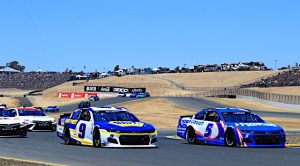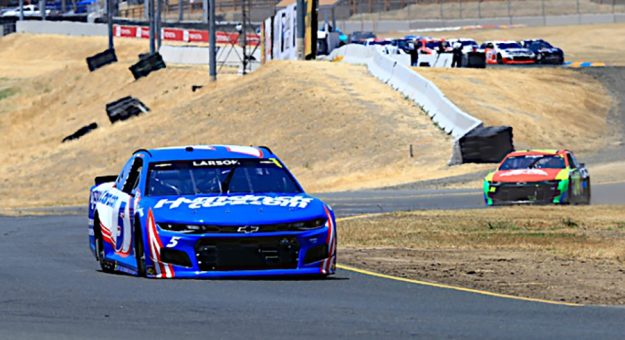For the last few years the biggest name in the road course racing game in NASCAR has been Hendrick Motorsports.
In 2021 alone, the organization amassed five road course wins via Chase Elliott (two) and Kyle Larson (three).
Larson’s wins – at Sonoma Raceway, Watkins Glen International and the Charlotte Roval – marked the first time a Cup driver had earned three road course wins in a single season (the Cup Series didn’t have more than two races on the schedule until 2018).
Though, really, Hendrick has been the biggest name on road courses for the last 35 years in the NASCAR Cup Series.
Heading into Sunday’s event at Sonoma Raceway, the Toyota/Save Mart 350, Hendrick has won 25 road course races in the Cup Series. Since the organization’s inaugural season in 1984, HMS has won 29% of all races on Cup road courses (25 of 86). The two closest teams in this statistic have combined for only 21 wins.
Larson, the defending Cup champion, will try to re-kindle some of his championship mojo at the the track that’s closest to his hometown of Elk Grove, California.
The driver of the No. 5 Chevrolet enters Sonoma with only one victory through 15 races. When the series arrived at Sonoma in 2021, Larson had two of his eventual 10 wins and had four consecutive finishes in the top two.
Larson would start from his fourth consecutive Sonoma pole, lead 57 laps and score his first career road course win.
But the Sonoma of 2022 is not the Sonoma of 2021. The same goes for the cars everyone will be driving.
Sonoma will be the second road course race for the Next Gen car after it debuted at Circuit of the Americas in April.
“It was cool to get my first win at my home track last year,” Larson said in a media release. “But that was with last year’s car and on the longer track.”
After two seasons of racing on the track’s original 2.52-mile circuit, which included the “Carousel,” Sonoma has returned to the 1.99-mile, 11-turn layout. That includes the “Chute,” a track section featuring two right-hand turns – Turn 4 and Turn 7 – that creates more potential passing opportunities.
Awh, chute! pic.twitter.com/D7O5RQPOUH
— NASCAR (@NASCAR) June 10, 2022
“The track layout will be a different element compared to the last couple trips we’ve made there,” Cliff Daniels, Larson’s crew chief, said in a media release. “We’ll place a little more emphasis on right-hand turns because so much focus was placed on the carousel and the left-hand turning capability of the car – and now we don’t race that portion of the track. It’s just going to race differently.”
Sunday’s race will consist 110 laps. The first stage concludes on Lap 25 and the second stage on Lap 55.
How the tires with an 18-inch profile wear over the course of a run will likely have an impact on pit strategy and competition.
“When I won here in 2011, the tires would go the full 30 laps, which is about the same on fuel,” Kurt Busch said Thursday. “Now the tires wear out much quicker and it seems like your strategy is split in half. Really, you’re only going 15 laps now because of how gooey and gummy and sticky the tires are, but then how much they drop off. You’re not necessarily racing the race backwards like we used to (when you) pit as soon as you could to make it on fuel. There might be some teams that choose that, go with that direction.”
Sonoma is a very technical track, with sharp turns and plenty of elevation changes.
What will it be like for the Next Gen car navigating “The Chute” along with the iconic hairpin in Turn 11?

“I think (the Chute will) fit our cars better,” Kevin Harvick said, comparing it to the “Carousel,” which was a long, sweeping left-hand turn.
“You have to funnel back in (exiting Turn 4) just because the wall comes out all the way to the racetrack,” Harvick said. “It’ll be interesting to see how our cars navigate the curb and all the things that slam into the ground when we cross that curb.”
Turn 11 is the biggest braking zone on the track after a high-speed section leading into it.
“It’s a pretty straightforward corner as far as braking, and that’s really what it comes down to – just who can get in there the hardest on the brakes and be able to keep the car under control and still make the bottom of the corner,” Harvick said.
Much has been made of the Next Gen car being designed specifically with road courses in mind, taking a lot after modern sports cars.
This year’s race at COTA, after an uneventful first stage, turned into one of the more dramatic road course events in recent memory, with Ross Chastain, AJ Allmendinger and Alex Bowman’s last-lap battle for the win, which went to Chastain.
“This car is faster on the road courses because it has more grip,” 2015 Sonoma winner Kyle Busch said in a media release. “It is a more central-built race car, meaning that it’s not just built to go left. I think the race should be competitive. All of the cars are the same, right? So, it should be more competitive. It’s just a matter of who runs over who that will determine whether we look like the local go-kart track or we look like professionals.”
